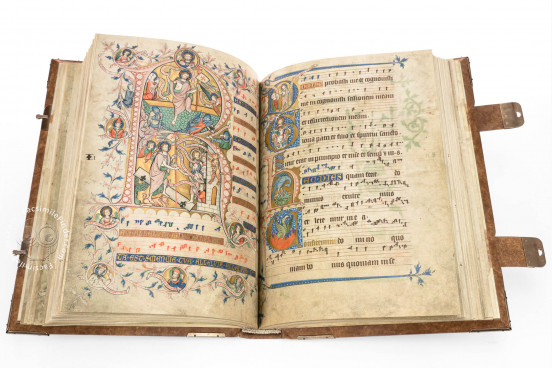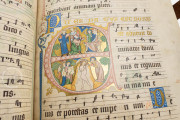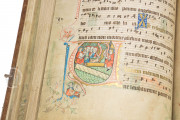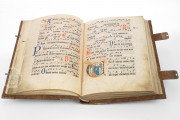The Gradual of Gisela von Kerssenbrock is a magnificently illuminated manuscript of notated chants for the Christian liturgy of the Mass. It is named for the Cistercian nun credited by an inscription in the book with having written, notated, and illuminated its pages. Created before 1300 at and for the community of Marianbrunn in Rulle in Lower Saxony, it is an imposing manuscript with fifty-three large and expertly rendered historiated initials that introduce chants of the major feasts of the Church year.
The manuscript contains the sung portions of the Mass arranged in liturgical order, beginning with Advent—the season of preparation for Easter. Its large size allowed a small choir of five or six to sing from the book propped up on a lectern during the services (as pictured in the initial for Christmas).
Gisela and Her Book
Although the claim for Gisela's responsibility for the book's production exaggerates her contribution—three scribes and at least two painters were involved—she is generally thought by scholars to have been responsible for directing the book's production and for having contributed significantly to the work of writing, notating, and illuminating the manuscript.
Gisela was probably the convent's cantrix (the nun responsible for the choir, the library, and solo singing in the liturgy). She is pictured twice in the manuscript—labeled with the diminutive version of her name, Gisle. In the initial for Christmas, we see her directing a group of nuns in singing (p. 25). At the beginning of Easter, she is pictured in the margin, kneeling in prayer (p. 139).
Brilliant Illumination with Scrolling Vines
The illumination is a fine expression of German Gothic manuscript art with brilliant coloration and ample use of gold leaf. The large historiated initials often sprout painted vines that extend into the margins and terminate in roundels populated by men and angels holding scrolls.
Many of the initials illustrate the event or person commemorated in the Mass for which the chants are present in the manuscript. For example, the historiated initial P for the principal Mass for Christmas shows the Nativity of Christ (p. 25). An unusual feature is that the scene shows Joseph offering the newborn to the Virgin Mary. The initial for the feast of the Ascension shows the lower body of Christ ascending into the clouds, with the apostles and the Virgin Mary looking on (p. 166). Christ's last footprints on Earth are visible on the stone below.
Writing in Gold and Notation in Colored Inks
The manuscript's text, written by three scribes, one of whom was Gisela, is remarkable for its generous use of display scripts and colored inks. The opening phrases of the first chants for the most important feast days are written in gold display script on colored bands, and the music notation is in red or blue above. This is a remarkable feature, indicating the high degree of planning behind the book's creation.
Gisela and her colleagues wrote in Gothic Textualis, the expected formal script for Christian liturgical manuscripts of the time. The melodies are in Hufnagel (horse-shoe nail) notation, named after the shape of its basic one-note neume.
Carl Clemens von Gruben (1764-1827) bequeathed the manuscript jointly to the Gymnasium Carolinum and the Priesterseminar in Osnabrück. From there it entered the Diözesanarchiv. Its current binding dates from 1925.
We have 1 facsimile edition of the manuscript "Gradual of Gisela von Kerssenbrock": Der Codex Gisle facsimile edition, published by Quaternio Verlag Luzern, 2014
Request Info / Price





























